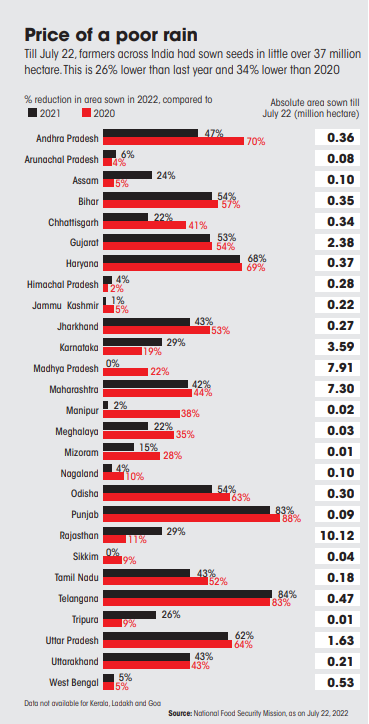Table of Contents
Down To Earth Magazine is a fortnightly magazine focusing on politics of environment and development, published in New Delhi, India.
UPSC Previous years’ questions on Development, Environment, Health and Disaster Management give us a clear idea about the increased importance of Down To Earth Magazine.
Down To Earth Magazine is one of the most important and indispensable source for UPSC Civil Services Exam Preparation. Keeping this in mind, here, we come with ”Gist Of Down To Earth Magazine” which covers important environmental current affairs articles in smooth pointed form, keeping in mind the demand of UPSC aspirants.
Dry June and Associated Problems: Introduction
- This year, June ended with an overall rain deficit of 8 per cent, with 18 states staring at a large deficit (60 to 99 per cent below long period average).
- Monsoon showers were largely absent over the southern peninsula, east and northeast, central and parts of north India, as per the India Meteorological Department (IMD).
- The situation changed drastically in July, and by the 22nd of the month, the monsoon was 10 per cent above normal.
- Rainfall in all the regions, except the east and northeast regions, was either close to normal, or comfortably above normal. But the damage had already been done by then.
- Till July 22, farmers had sown seeds in little over 37 million ha. This is 26 per cent lower than last year and 34 per cent lower than 2020, as per the National Food Security Mission dashboard.
Dry June and Associated Problems: Concern for Kharif Crop?
- Kharif accounts for nearly half of India’s annual food output. Paddy, the most important Kharif crop, is usually taken up for its nursery preparation in mid-June, and transplanting begins by July.
- As of July 16, almost 13 million ha paddy had been planted. It is still 2.68 million ha less than last year.
- All major paddy-growing states, including Punjab, Haryana, Bihar, Odisha, Uttar Pradesh, and Chhattisgarh, have recorded less sowing compared to the last two years.
- With June wasted, farmers can no longer sow medium- or long-duration crops because there is a risk of germination failure. Many farmers might not even sow crops this year.
Dry June and Associated Problems: What GOI is doing on this issue?
- Even the government is worried about the possible drop in paddy acreage and its likely impact on the public distribution system.
- At an event on July 5, Piyush Goyal, Union Minister for Consumer Affairs, Food and Public Distribution, urged farmers to grow more paddy this year, which is a departure from the usual government stance of asking farmers to diversify and move beyond paddy.
- There is an additional demand for rice this year since wheat production was alarmingly low, forcing the Centre to substitute it with rice under the National Food Security Act, 2013.
- So, the current situation cannot be called comfortable.
Dry June and Associated Problems: Monsoon Shift is Alarming
- A dry June is becoming a chronic problem for farmers.
- In nine of the past 12 years, the month was drier than normal in 10 or more meteorological sub-divisions, suggests IMD data.
- According to a 2019 paper published in the Economic and Political Weekly, rainfall during the Kharif season in Punjab has decreased by 7 per cent over the last 30 years.
- Like the arrival, the withdrawal of the monsoon season is also becoming erratic.
- In recent years, India has witnessed unseasonal rainfall in October, which destroys standing crops that are ready for harvesting.
- Plants need at least 15 dry days before they can be harvested.
Dry June and Associated Problems: What should be done?
- June is experiencing erratic rainfall and higher temperatures than normal. So we have shifted the sowing period from June to early July in the past few years.
- From the last few years, the monsoon has moved forward and important rain months have shifted to July and August.
- The country might need to realign its cropping cycles to the current climatological situation.
- While the monthly averages have remained more or less constant during the monsoon season, the intensity and frequency of rainy days might have changed over time.
- This must be mapped for at least 30 years or more.




 TSPSC Group 1 Question Paper 2024, Downl...
TSPSC Group 1 Question Paper 2024, Downl...
 TSPSC Group 1 Answer key 2024 Out, Downl...
TSPSC Group 1 Answer key 2024 Out, Downl...
 UPSC Prelims 2024 Question Paper, Downlo...
UPSC Prelims 2024 Question Paper, Downlo...





